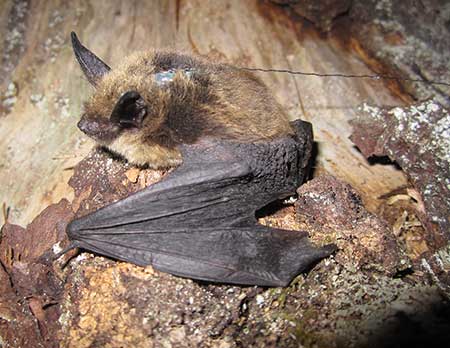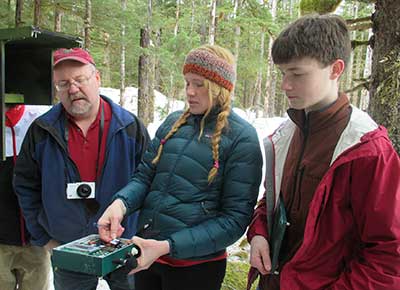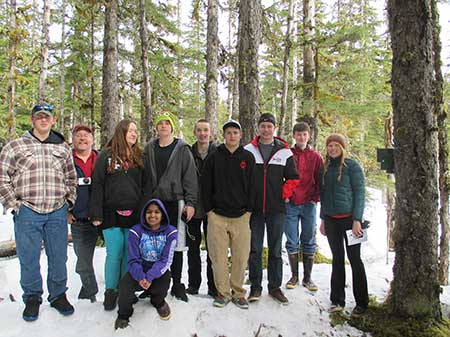Alaska Fish & Wildlife News
April 2014
Alaska’s Bat Monitors
How to be a Citizen Scientist

The bats emerged at dusk. As they crawled from their roost and fluttered into the falling dark to feed, two volunteers watched from below and counted - dozens, hundreds, and finally, more than a thousand.
Juneau isn’t known as a haven for bats, but this single roost in the Mendenhall Valley last summer shows that bats are at home in Southeast Alaska. Efforts in the past couple years to better understand Alaska’s bats have contributed significant insights into the kinds of bats present, the extent of their ranges and their behavior. Volunteers – citizen scientists – have been crucial to the work.
Wildlife biologist Michael Kohan spent the first week of spring in the small Southeast community of Gustavus, near Glacier Bay National Park, setting up a community bat monitoring program. She’s actually more of a facilitator, since volunteers are doing most of the work.
“It’s totally fueled by the Gustavus community,” she said. “They collect all the data, manage the data download, schedule all the surveys and email us the data.”

Bat monitoring was not hard to sell in Gustavus, a bat-friendly town. Kate Boesser, the community librarian, supported the idea and ran with it, helping organize a presentation and promoting the project. “She’s enthusiastic about science research in the community, and it’s contagious,” Kohan said. “Many people in Gustavus have bats on their property. They live with bats and they want to learn more about them.”
Volunteers are mapping bat roosting sites in the Gustavus area, and have charted a 30-mile driving survey route to monitor bats. Using a bat detector and recorder mounted to the roof of a vehicle, volunteers will drive the route twice a month and document the presence of bats. Kate Boesser said she’s signed up to drive the first survey.
“It’ll take a couple of hours, we’ll drive pretty slow, about 20 miles an hour,” she said. “The detector picks up information from about 90 feet away.”

Boesser has a sign-up sheet for the bat surveys in the library, has set up a bat display, and is using bats as a theme for reading. Materials in the library’s bat display will be updated throughout the summer as Gustavus residents learn more about their local bats. Boesser said in the 37 years she’s lived in her house she’s had bats living in a space that separates her stove chimney from her roof, and they’re not a problem.
“They’re wintering there. There’s no smell or anything, they can get in and out just fine,” she said. “This spring we’re going to count them when they come out. We see them flying around outside the house in the summer, and it’s nice to think of all the bugs they’re eating.”

Eric Hart, the school science teacher, is also involved and students will monitor a bat detector set up in the nearby national park.
“School science teachers have been integral to the success of the citizen science program,” Kohan said.
Volunteers will watch bat roosts at dusk and count bats as they come out to forage. “Monitoring roost emergence sounds complicated, but it’s not. It’s counting bats,” Kohan said.
Kohan is also setting up a program in Angoon – with the help of science teacher Jim Parkin – and would like to find citizen scientists in Haines and Juneau as well. “We’d love for anyone in Southeast interested in spearheading citizen science in their community to contact me about bat research. We have detectors and all the equipment, we just need volunteers. If anyone knows about any bat roosts in Juneau or anywhere in Southeast, we’d like to know. And if you’d like to monitor them, we’ll set you up.”

Kohan recently produced a four-minute video “Capturing Bats in Southeast Alaska” showcasing bats, mist-netting, bat processing and volunteers monitoring bats. The video is on the citizen science in Alaska webpage, which offers more information.
Kohan can be reached at michael.kohan@alaska.gov (907-465-8155). To learn more about bat monitoring and citizen science in South Central and Interior Alaska, contact Marian Snively marian.snively@alaska.gov (907-267-2893); or Dave Tessler david.tessler@alaska.gov (907-267-2332)
Riley Woodford discovered an attic full of bats in 1980 and has been a fan of these amazing mammals ever since.
Subscribe to be notified about new issues
Receive a monthly notice about new issues and articles.
